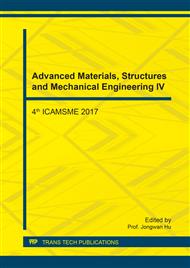[1]
D. Banerjee, and J. C. Williams, Perspectives on Titanium Science and Technology, Acta Mater. 61 (2013) 844-879.
Google Scholar
[2]
L. A. Ola, O. C. Harrysson, J. M. Denis, R. C. Denis, A. Harvey, Direct metal fabrication of titanium implants with tailored materials and mechanical properties suing electron beam melting technology, Mater. Sci. Eng. C 28 (2008) 366-373.
DOI: 10.1016/j.msec.2007.04.022
Google Scholar
[3]
I. Gibson, D. Rosen, B. Stucker, Additive Manufacturing Technologies: Rapid Prototyping to Direct Digital Manufacturing, second edition, Springer New York Heidelberg Dordrecht London, New York, (2009).
DOI: 10.1007/978-1-4939-2113-3
Google Scholar
[4]
E. M. Lawrence, et al., Metal Fabrication by Additive Manufacturing Using Laser and Electron Beam Melting Technologies, J. Mater. Sci. Technol. 28(1) (2012) 1-14.
Google Scholar
[5]
D. G. Lee, X. J. Mi, E. Kwan, Y. T. Lee, Bio-Compatible Properties of Ti-Nb-Zr Titanium Alloy with Extra Low Modulus, J. Biomater. Tissue Eng. 6 (2016) 798-801.
DOI: 10.1166/jbt.2016.1508
Google Scholar
[6]
L. E. Murr, S. M. Gaytan, A. Ceylan, E. Martinez, J. L. Martinez, D. H. Hernandez, B. I. Machado, D. A. Ramirez, F. Medina, S. Collins, R. B. Wicker, Acta Materialia 58 (2010) 1887-1894.
DOI: 10.1016/j.actamat.2009.11.032
Google Scholar
[7]
K. Rafi. H. Karthik, N. V. Thomas, L. Starr. and E. S. Brent, Mechanical property evaluation of Ti-6Al-4V parts made using Electron Beam Melting, Proc. Solid Freeform Fabrication Symposium (2012) 526-535.
Google Scholar
[8]
M. Koike, K. Martinez, L. Guo, G. Chahine, R. Kovacevic, and T. Okabe, Evaluation of titanium alloy fabricated using electron beam melting system for dental applications, J. Mater. Process. Technol. 211 (2011) 1400-1408.
DOI: 10.1016/j.jmatprotec.2011.03.013
Google Scholar
[9]
L. E. Murr, E. V. Esquivel, S. A. Quinones, S. M. Gaytan, M. I. Lopez, E. Y. Martinez, F. Medina, D. H. Hernandez, E. Martinez, J. L. Martinez, S. W. Stafford, D. K. Brown, T. Hoppe, W. Meyers, U. Lindhe, and R. B. Wicker, Microstructures and mechanical properties of electron beam-rapid manufactured Ti-6Al-4V biomedical prototypes compared to wrought Ti-6Al-4V, Mater. Character. 60 (2009).
DOI: 10.1016/j.matchar.2008.07.006
Google Scholar
[10]
S. Biamino, A. Penna, U. Ackelid, S. Sabbadini, O. Tassa, P. Fino, M. Pavese, P. Gennaro, and C. Badini, Electron beam melting of Ti-48Al-2Cr-2Nb alloy: Microstruct. Mech. Propert. Invest. Intermetall. 19 (2011) 776-781.
DOI: 10.1016/j.intermet.2010.11.017
Google Scholar
[11]
C. W. Lin, C. P. Ju, and J. Lin, Comparison among Mechanical Properties of Investment-Cast c. p. Ti, Ti-6Al-7Nb and Ti-15Mo-1Bi Alloys, Mater. Trans. JIM 45 (2004) 3028-3032.
DOI: 10.2320/matertrans.45.3028
Google Scholar
[12]
C. W. Lin, C. P. Ju, and J. Lin, A comparison of the fatigue behavior of cast Ti-7. 5Mo with c. p. titanium, Ti-6Al-4V and Ti-13Nb-13Zr alloys, Biomater. 26 (2005) 2899-2907.
DOI: 10.1016/j.biomaterials.2004.09.007
Google Scholar
[13]
H. Gong, K. Rafi, H. Gu, G. D. Janaki Ram, T. Starr, and B. Stucker, Influence of defects on mechanical properties of Ti-6Al-4V components produced by selective laser melting and electron beam melting, Mater. Des. 86 (2015) 545-554.
DOI: 10.1016/j.matdes.2015.07.147
Google Scholar
[14]
X. Shui, K. Yamanaka, M. Mori, Y. Nagata, K. Kurita, and A. Chiba, Effects of post-processing on cyclic fatigue response of a titanium alloy additively manufactured by electron beam melting, Mater. Sci. Eng. A 680 (2017) 239-248.
DOI: 10.1016/j.msea.2016.10.059
Google Scholar
[15]
J. Gunther, D. Krewerth, T. Lippmann, S. Leuders, T. Troster, A. Weidner, H. Biermann, and T. Niendorf, Fatigue life of additively manufactured Ti-6Al-4V in the very high cycle fatigue regime, Int. J. Fatigue 94 (2017) 236-245.
DOI: 10.1016/j.ijfatigue.2016.05.018
Google Scholar


